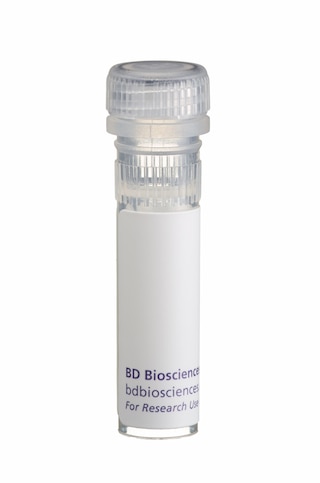-
Your selected country is
Middle East / Africa
- Change country/language
Old Browser
This page has been recently translated and is available in French now.
Looks like you're visiting us from {countryName}.
Would you like to stay on the current country site or be switched to your country?


Regulatory Status Legend
Any use of products other than the permitted use without the express written authorization of Becton, Dickinson and Company is strictly prohibited.
Preparation And Storage
Recommended Assay Procedures
ELISA Capture: The purified MP5-20F3 antibody (Cat. No. 554400) is useful as a capture antibody for a sandwich ELISA for measuring mouse IL-6 protein levels. Purified MP5-20F3 antibody can be paired with the biotinylated MP5-32C11 antibody (Cat. No. 554402) as the detecting antibody, with recombinant mouse IL-6 (Cat. No. 554582) as the standard. Purified MP5-20F3 antibody should be titrated 2-6 µg/ml to determine optimal concentration for ELISA capture. To obtain linear standard curves, doubling dilutions of mouse IL-6 ranging from ~2000 to 15 pg/ml are recommended for inclusion in each ELISA plate. For specific methodology please visit the protocols sections or the chapter on ELISA in the Immune Function Handbook, both of which are posted on our website, www.bdbiosciences.com.
Note: This ELISA pair is recommended primarily for measuring cytokine from experimental cell culture systems. These ELISA reagents are not recommended for assaying serum or plasma samples. For measuring mouse IL-6 in serum or plasma our mouse IL-6 BD OptEIA™ set (Cat. No. 555240) or BD OptEIA™ Kit (Cat. No. 550950) are specifically formulated and recommended.
Blocking Control for Intracellular Staining: The purified MP5-20F3 antibody (Cat. No. 554400) can be used as a blocking control to demonstrate specificity of IL-6 staining by the PE-conjugated MP5-20F3 antibody (Cat. No. 554401). To perform this control, the fixed/permeabilized cells (~1 million) can be incubated with 1 - 10 µg of purified MP5-20F3 antibody (Cat. No. 554400) for 20 minutes at 4°C, prior to staining with the PE-MP5-20F3 antibody (e.g., 0.1 - 0.5 µg mAb/1 million cells). The intracellular cytokine staining technique and use of blocking controls are described in detail by C. Prussin and D. Metcalfe. For specific methodology, please visit the protocols section or chapter on intracellular staining in the Immune Function Handbook, both of which are posted on our website, www.bdbiosciences.com.
Neutralization: The BD NA/LE™ MP5-20F3 antibody (Cat. No. 554398) is useful for neutralization of mouse IL-6 bioactivity. A suitable BD NA/LE™ rat IgG1 isotype-matched control is the R3-34 antibody (Cat. No. 554682).
Western Blot: The MP5-20F3 antibody has been reported to be useful for Western blotting. Please note that this application is not routinely tested at BD Biosciences Pharmingen.
Product Notices
- Since applications vary, each investigator should titrate the reagent to obtain optimal results.
- Please refer to www.bdbiosciences.com/us/s/resources for technical protocols.
- Caution: Sodium azide yields highly toxic hydrazoic acid under acidic conditions. Dilute azide compounds in running water before discarding to avoid accumulation of potentially explosive deposits in plumbing.
The MP5-20F3 monoclonal antibody specifically binds to mouse interleukin-6 (IL-6). The immunogen used to generate the MP5-20F3 hybridoma was recombinant mouse IL-6.
Development References (6)
-
Abrams J. Immunoenzymetric assay of mouse and human cytokines using NIP-labeled anti-cytokine antibodies. Curr Protoc Immunol. 2001; 1:6.20-6.21. (Clone-specific: ELISA). View Reference
-
Abrams JS, Roncarolo MG, Yssel H, Andersson U, Gleich GJ, Silver JE. Strategies of anti-cytokine monoclonal antibody development: immunoassay of IL-10 and IL-5 in clinical samples. Immunol Rev. 1992; 127:5-24. (Clone-specific: ELISA, Neutralization). View Reference
-
Prussin C, Metcalfe DD. Detection of intracytoplasmic cytokine using flow cytometry and directly conjugated anti-cytokine antibodies. J Immunol Methods. 1995; 188(1):117-128. (Methodology: IC/FCM Block). View Reference
-
Sander B, Hoiden I, Andersson U, Moller E, Abrams JS. Similar frequencies and kinetics of cytokine producing cells in murine peripheral blood and spleen. Cytokine detection by immunoassay and intracellular immunostaining. J Immunol Methods. 1993; 166(2):201-214. (Clone-specific: ELISA). View Reference
-
Starnes HF Jr, Pearce MK, Tewari A, Yim JH, Zou JC, Abrams JS. Anti-IL-6 monoclonal antibodies protect against lethal Escherichia coli infection and lethal tumor necrosis factor-alpha challenge in mice. J Immunol. 1990; 145(12):4185-4191. (Clone-specific: Neutralization). View Reference
-
Suda T, O'Garra A, MacNeil I, Fischer M, Bond MW, Zlotnik A. Identification of a novel thymocyte growth-promoting factor derived from B cell lymphomas. Cell Immunol. 1990; 129(1):228-240. (Clone-specific: Neutralization). View Reference
Please refer to Support Documents for Quality Certificates
Global - Refer to manufacturer's instructions for use and related User Manuals and Technical data sheets before using this products as described
Comparisons, where applicable, are made against older BD Technology, manual methods or are general performance claims. Comparisons are not made against non-BD technologies, unless otherwise noted.
For Research Use Only. Not for use in diagnostic or therapeutic procedures.
Report a Site Issue
This form is intended to help us improve our website experience. For other support, please visit our Contact Us page.
